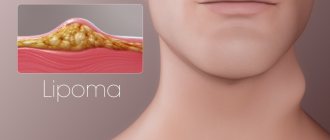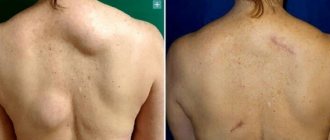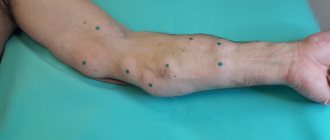Surgeon
Bohyan
Tigran Surenovich
Experience 37 years
Surgeon of the highest category, Doctor of Medical Sciences, member of the International Association of Surgeons, Gastroenterologists and Oncologists
Make an appointment
Lipoma (fat) is a benign formation in the form of small nodules, the appearance of which is associated with the accumulation and compaction of excess adipose tissue. The size of the lipoma may increase or remain stable. When exposed to unfavorable factors, pockets of pathogenic microflora can form inside the wen, which makes it a source of other serious diseases of internal organs. The unaesthetic appearance of formations protruding on the surface of the skin is also important. Therefore, in most cases, a decision is made to remove the tumor and its subsequent histological examination to clarify the nature of the wen - benign or malignant.
The area of localization of lipoma is the back, chest, face, limbs, mammary glands, structure of internal organs. The formation can be detected accidentally during diagnostic procedures or during palpation. The edges of the lipoma are dense and clear, the formation is mobile, and its palpation is painless. It is more difficult to detect a lipoma in the tissues of internal organs. However, it is precisely such cases that are recognized as the most dangerous, threatening disruptions in the functioning of the affected tissue area.
Classification
Depending on the internal structure there are:
- Myolipomas are formations from muscle cells.
- Angiolipomas are lipomas with the inclusion of blood vessels.
- Myxolipomas are tumors containing mucus.
- Fibrolipomas are formations containing connective tissue.
It is possible to accurately determine the nature of the formation only after a thorough diagnosis. It should not be postponed for the foreseeable future, especially if the lipoma quickly increases in size and causes discomfort.
Prevention
The basis of prevention is represented by increasing the body’s immune forces and reducing the impact of negative factors on the lungs.
It is necessary to stop smoking. Tobacco smoke has a very negative effect on lung tissue. It is necessary to reduce the consumption of alcoholic beverages, which undermine the immune system.
Regular exercise will ensure your lungs have adequate ventilation. Medical examinations twice a year will ensure early diagnosis of all neoplasms.
Timely treatment of respiratory system infections will eliminate them as a factor in the occurrence of lipoma.
Lung lipoma is a relatively harmless and rare tumor. The chance of its occurrence in the lungs tends to zero. But if it has formed, removal with timely diagnosis is not difficult. A favorable prognosis allows the patient to forget about this disease forever after all procedures.
Causes of lipoma
The general pattern of the appearance of wen is the accumulation of fat cells due to a violation of fat metabolism in the body. If measures to treat the problem are not taken in a timely manner, the formation quickly grows, pinching nearby muscles and blood vessels. Among the causes of lipoma that influence the unfavorable course of the pathology, it is worth noting:
- Hormonal disorders, a period of hormonal changes in the body.
- Metabolic failures.
- Disturbances in the diet with a predominance of food of animal origin.
- Diseases of the kidneys and liver, pancreas and thyroid gland.
- Bad habits.
- Diabetes.
- Genetic predisposition.
Also, the formation of excess adipose tissue is affected by physical inactivity, a sedentary lifestyle and refusal of full-fledged physical activity.
Symptoms
The main localization of wen is the place of deposition of adipose tissue. At first it is a soft compaction, which gradually increases in size. The only symptom of a lipoma is the formation of a noticeable tubercle with a movable structure, which can be felt when pressed. There is no pain when palpating the lipoma on the back or arms.
If the wen is localized in the structure or on the surface of internal organs, disturbances in their functioning may indicate pathology. The disease is also accompanied by characteristic symptoms:
- a lipoma in the esophagus causes coughing, nausea and vomiting;
- formations on the bronchi and trachea cause a constant dry cough of a paroxysmal nature;
- lipoma on tendons and cartilage limits their mobility and causes pain;
- a lump in the mammary gland gives pain;
- fatty deposits in the kidneys provoke colic, lower back pain, and increased blood pressure;
- a lipoma in the head causes dizziness and headaches;
- a formation in the neck makes it difficult to swallow food and also causes hoarseness;
- A lipoma in the heart area causes arrhythmia and heart failure.
Are you experiencing lipoma symptoms?
Only a doctor can accurately diagnose the disease. Don't delay your consultation - call
Services and prices
Removal of lipoma more than 3 cm
7000 ₽
Sign up
Removal of lipoma up to 3 cm
4000 ₽
Sign up
Lipoma is the most common soft tissue tumor and consists of fat cells surrounded by a thin fibrous capsule. Popularly, such a neoplasm is called a wen.
Often, a person who is attentive to his body may stumble upon such a subcutaneous formation. Such a finding can cause, at a minimum, caution, and sometimes fear of the oncological process. The unknown is always scary. If you have any concerns, you should consult your doctor. In most cases, subcutaneous neoplasms in soft tissues are benign and do not pose a threat to the owner of the wen. However, lipomas still require the supervision of a specialist who must recognize a malignant process, if one occurs.
Peculiar red flags, signs that make you wary, are rapid tumor growth, pain, and the presence of two or more similar formations on the body.
By external signs, lipoma is little distinguishable from liposarcoma, hygroma, subcutaneous cyst, hematoma, parasitic invasion, inflammation or consequences of injury. Therefore, it is important that any neoplasms be examined by a doctor.
First of all, the question of the malignancy of the tumor is decided at the appointment. Liposarcoma occurs more often in middle-aged and elderly people. This is an aggressive and fast-growing tumor that can put pressure on surrounding organs and tissues and cause pain. Situations when an existing lipoma degenerates into a malignant tumor rarely occur. However, the oncological process requires a radically different approach to diagnosis and treatment, so it is important to diagnose it as early as possible.
Lipomas may have a hereditary predisposition. This fact, combined with the spread of wen to other parts of the body, makes the doctor suspect lipomatosis. Lipomatosis accompanies a number of hereditary syndromes such as Madelung's disease and Dercum's syndrome. Diseases with a family history require a special approach to therapy.
Methods for diagnosing lipomas
The long period of latent progression greatly complicates the diagnosis of soft tissue lipoma in the early stages of development. More often, pathology is detected when the wen reaches a size of 1.5-2 cm and is easily palpable under the skin. To carry out differentiated diagnostics and confirm the benign nature of the formation, you can:
- Blood tests to exclude viral or bacterial infections, as well as the absence of an inflammatory process.
- X-ray of the chest, limbs or abdomen. Allows you to detect a formation, clarify its location, calculate its size and assess the condition of surrounding tissues.
- Ultrasonography. It is used as an additional diagnostic method when the presence of a lipoma is confirmed by other examination methods.
- Computed and magnetic resonance imaging. Effective methods to determine the location and size of the lipoma, as well as confirm its benign nature.
- A biopsy of wen tissue to analyze it for the risk of cells degenerating into a malignant structure.
If the patient has other diseases of the internal organs, the diagnosis of lipoma is carried out taking into account their characteristics, and deciphering the results suggests the mutual influence of pathologies, making it possible to more accurately determine the cause of the appearance of the wen.
Causal factors of appearance
The basis for the formation of lung lipoma is considered to be a hereditary predisposition to this type of tumor. And its development is caused by some predisposing and particular factors that modern medicine identifies.
Predisposing factors:
- Viruses that involve the lungs in the infectious process. Their consequences become a trigger for the development of education.
- Inhalation of vapors of harmful substances that damage lung tissue.
- Smoking in all its forms.
- Excessive ultraviolet baths (natural/artificial).
- Consuming heavy metals with water, inhaling them through vapors.
Particular factors are represented by inflammatory diseases of the respiratory system, such as: chronic obstructive pulmonary disease, bronchial asthma, pneumonia, tuberculosis, bronchiectasis.
Inflammation of the bronchi significantly increases the possibility of failure of the cell program and the beginning of their spontaneous proliferation.
These factors significantly increase the possibility of lipoma. But without the presence of a hereditary factor, the rest are not significant.
Treatment
If small lipomas are detected in a patient, a wait-and-see approach is chosen, which involves ultrasound monitoring several times a year. However, there are often cases when the doctor decides in favor of surgical intervention. Surgery is necessary if:
- The tumor grows rapidly, engulfing neighboring tissues and blood vessels.
- The lipoma rises above the surface of the skin, giving an unaesthetic cosmetic effect.
- The development of a wen gives persistent pain.
- Due to the growth of adipose tissue, the functioning of internal organs and the circulatory system is disrupted.
Removing or destroying a lipoma on the neck or back is possible in the following ways:
- Endoscopic method. It involves removing the tumor along with the capsule through a small incision in the skin.
- Liposuction is the extraction of adipose tissue by softening it and stretching it through a thin needle. Does not leave scars and does not injure the skin.
- Excision of a lipoma is the removal of a wen during a classic surgical intervention.
The optimal method is selected taking into account the general condition of the patient and the size of the lipoma.
What to do when opening a tumor
If the wen ruptures, then pus flows out first. A burst lipoma is dangerous due to the penetration of pathogenic microorganisms into the wound. To protect yourself from complications, you should do the following:
- Wash well several times .
- Using sterile cotton wool or a napkin, carefully remove the released purulent contents.
- Apply antiseptic .
- Secure the sterile bandage with a bandage or plaster.
- Go to the doctor.
If the purulent mass has stopped flowing, then you should not squeeze out the lipoma yourself. In the clinic, a dermatologist must conduct an external examination of the affected area, assess the degree of neglect of the pathology and prescribe effective therapy in the form of complete elimination of the tumor.
Self-removal of the remnants of a burst wen can be dangerous not only due to infectious complications, but also to the rapid recurrence of the tumor.
In order to avoid the recurrence of a lipoma, the tumor must be removed surgically.Until you visit the surgeon, the burst wen must be covered with a sterile gauze pad and secured with an adhesive plaster.
Cosmetologist, dermatologist, trichologist
Kalinina Olga Alexandrovna
4 years of experience
To exclude the malignant nature of the lipoma, the released mass is examined in the laboratory before removal. Often the patient mistakes a wen for atheroma, which occurs due to blockage of the sebaceous glands. When the second tumor is opened, yellow-green pus with an unpleasant odor comes out.
Small formations are removed by a dermatologist or cosmetologist, but it is better not to use the services of beauty salons in such cases. At the initial stage, specialists prescribe absorbable agents.
Why can our articles be trusted?
We make health information clear, accessible and relevant.
- All articles are checked by practicing doctors.
- We take scientific literature and the latest research as a basis.
- We publish detailed articles that answer all questions.
If the lipoma has reached a significant size, the cavity is cleaned mechanically. Wen are especially dangerous near the lymphatic system: in the armpit, knee, elbow, groin area or under the jaw. Such lipomas must be constantly monitored by a doctor.
A few months after the inflammatory process has subsided, the specialist removes the tumor. During surgery, a complete incision of the ruptured lipoma occurs, followed by clearing out the pathological tissue and removing the capsule.
This operation eliminates relapses. Surgical removal operates under local anesthesia and is therefore painless. The average duration of the procedure is ten minutes, after which a minor or large scar remains.
Which doctor treats wen
A fatty tumor is a benign tumor that forms under the skin.
Endoscopic removal allows an incision to be made near the wen, for example in the armpit or in the hair. After the incision, the instrument penetrates under the skin and passes directly to the desired object.
This procedure will also not take much time, and will avoid visible scars. However, due to the use of modern equipment, the cost of such manipulation is higher than surgical intervention.
Laser removal is the newest way to eliminate lipomas. This gentle method is most often used on areas of the body with thin, delicate epithelium.
Another advantage of using a laser is the absence of scars after manipulation. To avoid bleeding, the wen and surrounding tissues heat up, resulting in “sealing” of the vessels.
Diagnosis and treatment of lipoma at the JSC Meditsina clinic in Moscow
The clinic of JSC "Medicine" in the Central Administrative District of Moscow is ready to offer professional assistance to patients with suspected single or multiple cases of lipoma development. The center’s specialists have high-quality equipment and extensive practical experience in using various methods of removing a tumor focus. Each patient is guaranteed attentive attention, referral to a full course of examinations and an individual approach to developing lipoma treatment tactics. Appointments are available on the clinic’s website and by calling the numbers provided.











